|
Cone & Seed Insect Pests
Importance (really means
economic threat ... $$)
 | ~1/4 billion seedlings planted/year in BC
 | but nurseries grow more seedlings (300-350 million) to account
for culls |
 | need to sow even more seed (not 100% germination)
|
|
 | 70-75% seed from wild stands / 25-30% from seed orchards
 | seeds from seed orchards are expen$ive ... heavily managed
... (plus tree selection, grafting, fertilization, studies, etc) |
 | seed orchard trees are bred for favorable characteristics: fast growth,
quality wood, resistance to insects & disease |
 | seeds from wild stands not nearly the same concern (just monitor to
ensure collection efforts are not wasted)
|
|
 | insect losses can be significant (and therefore a concern)
 | crops following a heavy cone crop are often heavily hit (and visa versa)
- this makes sense to me |
 | BUT also some heavy cone crop years are heavily hit even if previous
cone crop year was low ... hmmm ... let me think |
 | luckily only ~100 species of the 50,000+ known species in Canada are
conophytes (cone/seed eaters) |
|
Management Overview
 |
Direct vs. Indirect Pests
 |
direct pests lay
eggs within the
cone (between cone scales during flowering or within the seed when cone is
1/2 grown)
these pests are difficult to
detect as they are inside the cone without feeding evidence
|
 |
indirect pests lay eggs on the
outside or near the cone
these pests are easier to detect
as there will be entrance holes + frass
|
|
 |
For wild seed collections ...
primarily monitor cone crop just prior to collection to determine insect/
disease levels
|
 |
For seed orchards it used to be set
spray dates ... now ... IPM and breeding for resistant stock
 |
IPM (the following describes how to
minimize damage)
 |
monitoring pests at all stages
(flowering, conelets to mature cones) |
 |
consider history (previous year's
crop size and damage level) & predicted crop size (a bumper year?) |
 |
ID pests |
 |
assess damage* (impact on seed
production) |
 |
decide on treatment options
(biological, mechanical, cultural, chemical - chemical difficult due to
location of most seed orchards) |
 |
implement plan |
 |
monitor results (to provide
improvements for future treatments)
|
|
 |
* Assessment of impact on seed
production (want a value that = actual / potential)
-
For each tree species: select a
sample of trees (2-5%) and count ALL new cones (including dead & damaged) = pot'l seed crop
-
From this sample select a
sub-sample of cones (~25) to monitor that season - and tag them
-
Assess cones 2-4 times during
season (e.g. start of flowering, cone formation, 1/2 size cone, full-size
cone) and assess damage level
-
Enter data into a pop'n
prediction model to predict damage (and determine treatment option, as above
under IPM)
-
Collect mature cones and
extract/germinate seeds to determine actual seed production and
compare with predictions (this way improvements can be made to pop'n model)
|
|
Facultative vs. Obligate
Conophytes
 |
Facultative conophytes can feed on
both cone/seed material and other material (i.e. can survive without cone/seeds)
|
 |
Obligate conophytes
require
cone/seed material to complete their life cycle, these critters are much more
"in tune" with cone crops
|
* Extended Diapause
- Risk Spreading vs. Predictive
 |
risk spreading - eggs
are genetically programmed for diapause of various lengths (e.g. 30% in yr 1, 40%
in yr 2, 30% in yr 3) - e.g. spruce cone moth
obviously this spreads
eggs hatching over various cone crops (bumper years & "droughts") and "spreads
the risk"
|
 |
predictive - eggs are
tied to the same cues as trees regarding cone crops - hatch when there is a
bumper crop - e.g. Douglas-fir come moth
|
Selected Key
Players
 |
Unlike other "tissue
feeders" (e.g. defoliators, bark beetles, etc.) where few insect orders are
involved, several insect orders utilize cone/seed tissue - not a surprise when
you consider the nutrition of the tissue
|
 |
key orders are
 |
lepidoptera (40-45%) -
some are generalists/facultative, others are specialists/obligate
|
 |
hemiptera (homoptera)
(40-45%) - typically specialists/obligate [in BC ... w. conifer seed bug, a.k.a.
the leaf-footed bug]
|
 |
hymenoptera (~10%) -
specialists [seed chalsids]
|
 |
diptera (not many spp.
in BC, but can be important)
|
 |
coleoptera
|
 |
thysanoptera (thrips)
|
|
 |
selected examples
 |
western (spruce)
budworm [lepidoptera] is the most significant
generalist that damages cones/seeds in BC
 |
grazes the the outside
of cones - cones don't open
|
 |
plenty of s&s on
outside (partially consumed cone, frass & webbing)
|
|
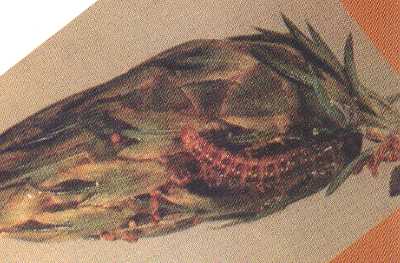
 |
cone worms
(Dyoryctia spp.) [lepidoptera] - damage apparent on the outside of the cone
(large holes, frass & webbing) - tunnel inside the cone but push frass to the
outside
|
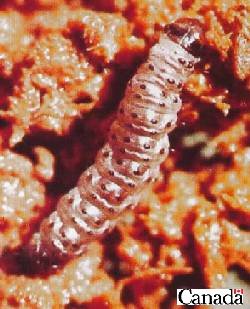
 |
cone moths
(Barbara spp.) [lepidoptera] - damage can be apparent on the outside of small cones
(less noticable on larger cones), larva feeds inside on cone scales & seeds,
causes resin flow that prevents cone from opening when it matures
|
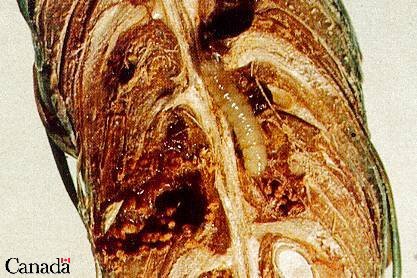
 |
western conifer
seed bug also the leaf-footed bug (Leptoglosis spp.)
[hemiptera] - damage not apparent as the bug inserts stylet into cone to digest
& suck up the seed contents
|
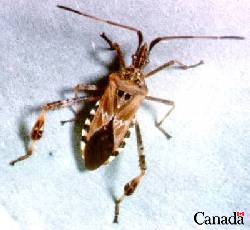
 |
seed chalcids
(Megastigmus spp.) [hymenoptera] can damage 10% of seeds in BC, but has been
introduced into France and damage up to 100% of seed crop of Fd
|
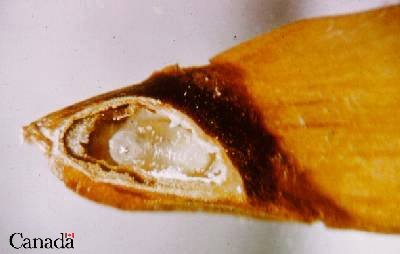
 |
cone gall midges
(Contarinia spp.) [diptera] - is the main pest of Fd cone crops in BC, cones
brown prematurely, galls inside (cone scales)
|
|
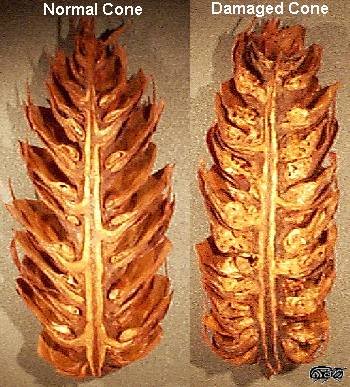
Images from Fetch21
|





